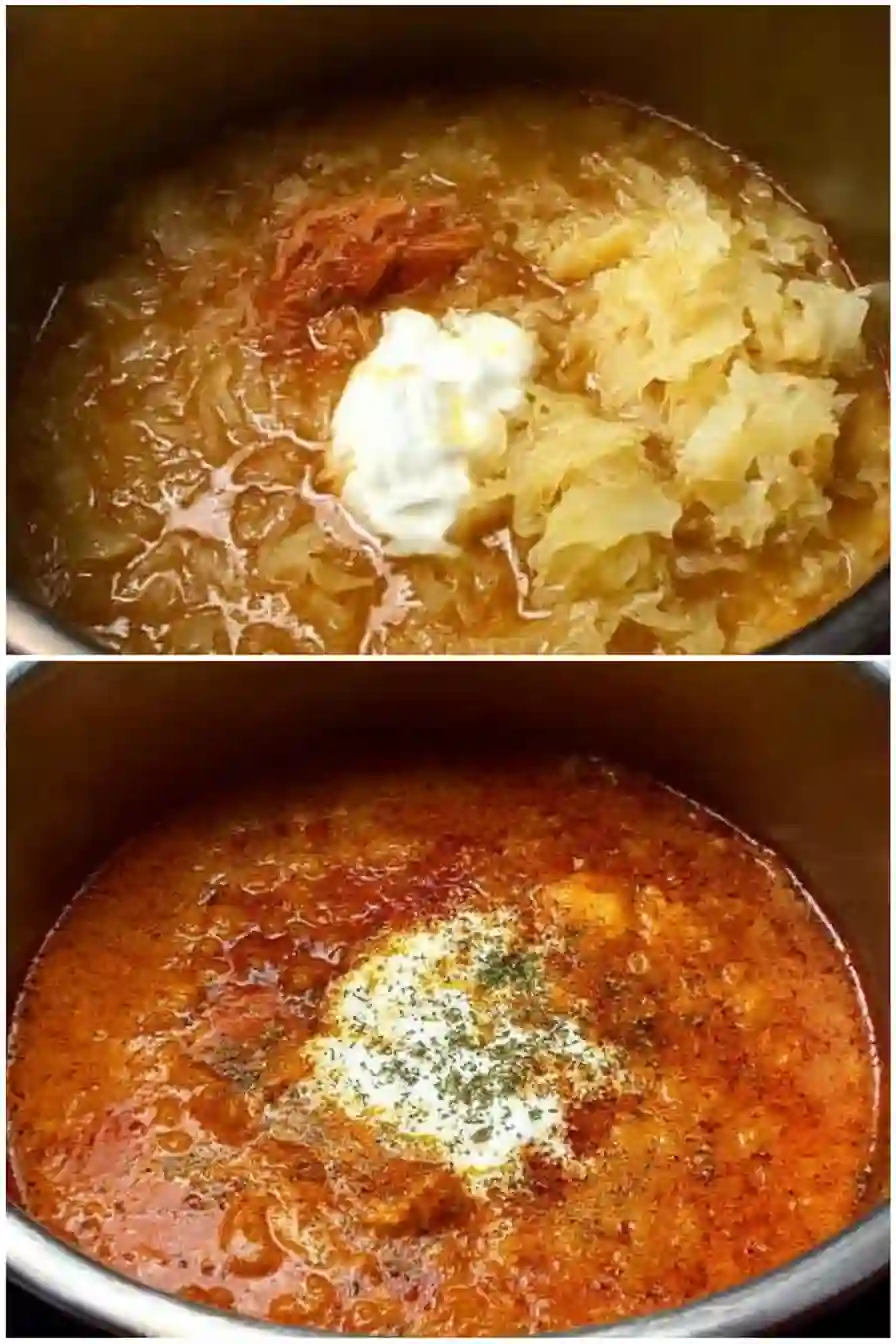
If you’ve never had German sauerkraut soup, you’re about to fall in love with one of the most comforting, flavorful, and soul-warming dishes you can make in a single pot. This isn’t your average cabbage soup it’s richer, heartier, and layered with smoky bacon, tender potatoes, and the unmistakable tang of sauerkraut that makes every spoonful crave-worthy.
let’s connect in pinterest.com/touimaz/
I first discovered sauerkraut soup on a frosty November evening when a friend from Wisconsin handed me a steaming bowl after a long drive. The scent hit me first savory onions, garlic, and that tangy sauerkraut note that instantly woke up my appetite. One bite later, I was hooked. It was rustic, deeply satisfying, and tasted like something that had been simmering for generations.
table of contents
Back home in Asheville, North Carolina, I couldn’t get it out of my head. So I recreated it Nancy-style. With smoky sausage, a hint of paprika, and a little patience, I learned that German sauerkraut soup is one of those dishes that feels like comfort food magic. It’s hearty enough for dinner yet simple enough for a weekday meal. The best part? It tastes even better the next day as the flavors deepen and mingle.
Making sauerkraut soup taught me something about cooking: sometimes, the simplest ingredients—like cabbage, broth, and potatoes—create the most memorable meals. Every spoonful is tangy, rich, and grounding, especially when paired with crusty bread or even a slice of pumpkin banana loaf.
If you’ve been searching for a warm, comforting soup that’s full of history, heart, and healthy fermented flavor, sauerkraut soup might just become your new favorite recipe. It’s a dish that connects generations and fills your kitchen with the best kind of warmth.
ngredients & Prep Made Simple
The beauty of sauerkraut soup lies in how effortlessly it comes together. With just a few pantry staples and one pot, you can create a rich, tangy, and deeply comforting meal that tastes like it’s been simmering all day. What makes German sauerkraut soup stand out is its balance—savory, slightly sour, and packed with texture.
Below is a quick look at what makes up a perfect pot of sauerkraut soup, whether you stick to tradition or give it a modern twist.| Traditional German Ingredients | Modern Additions |
|---|---|
| Homemade sauerkraut (fermented cabbage) | Canned or jarred sauerkraut for convenience |
| Smoked sausage or bacon | Turkey sausage or vegan smoked tofu |
| Potatoes, onions, and carrots | Sweet potatoes or parsnips for sweetness |
| Beef or chicken broth | Vegetable stock for a lighter version |
If you’re short on time, store-bought sauerkraut works just fine. Just make sure to drain it before adding to your soup, so you can control the tanginess. For extra flavor, sauté your onions and sausage first until golden this step deepens the taste and gives sauerkraut soup its signature savory aroma.
Pairing this soup with other hearty recipes like crispy dill pickle parmesan chicken makes for the ultimate comfort meal when temperatures drop.
Next time you need something warm, filling, and full of character, remember: a pot of sauerkraut soup is all you need to bring a bit of cozy, old-world magic to your table.
Cooking German Sauerkraut Soup (Step-by-Step Guide)
Making German sauerkraut soup is all about layering flavor. You don’t need fancy tools or ingredients—just a sturdy pot, a wooden spoon, and about 45 minutes to create something that tastes like it simmered all day.
Here’s how I make my go-to pot of sauerkraut soup, one that warms both heart and home.

- Start with the base.
Heat a tablespoon of oil or butter in a large soup pot over medium heat. Add chopped onions, carrots, and minced garlic. Sauté until fragrant and lightly golden this builds a sweet, savory backbone for the tangy sauerkraut that comes next. - Add your flavor builders.
Stir in diced smoked sausage or bacon for richness. For a lighter version, use turkey sausage or keep it vegetarian with mushrooms. Sprinkle in paprika, caraway seeds, and a touch of black pepper for classic German depth. - Add the star ingredient sauerkraut.
Now the magic happens. Stir in your drained sauerkraut, letting it mingle with the vegetables and sausage. This step brings that unmistakable tang that makes sauerkraut soup shine. - Pour in the broth.
Add chicken, beef, or vegetable broth enough to cover everything by about an inch. Bring to a boil, then reduce heat and simmer for 25–30 minutes. The flavors will meld beautifully, and the broth will thicken slightly. - Add potatoes and finish.
Toss in cubed potatoes about halfway through cooking. When tender, taste and adjust seasoning. Some people like to add a spoonful of tomato paste or a dash of cream for richness it’s your kitchen, your rules.
Once it’s done, your sauerkraut soup should be thick, tangy, and full of flavor. The smell alone is enough to draw everyone to the table. Serve it hot, with a slice of rye bread or even something sweet like Earl Grey cookies for a cozy contrast.
If you have leftovers, lucky you,sauerkraut soup tastes even better the next day as the flavors deepen overnight. Just reheat it gently on the stove or in the microwave, and it’s ready to comfort you all over again.
Health, Culture & Serving
Is Sauerkraut Soup Good for You?
Absolutely! One of the biggest reasons sauerkraut soup has remained beloved across generations is its health value. Sauerkraut is simply fermented cabbage, which means it’s rich in probiotics those friendly bacteria that support gut health and digestion. When gently heated in soup, it retains some of those natural benefits while bringing a tangy flavor no other ingredient can match.
Each bowl of German sauerkraut soup delivers a wholesome balance of vitamins from cabbage, fiber from potatoes and carrots, and protein from sausage or beans. It’s filling, hearty, and naturally low in fat when made with lean ingredients. Pair it with light sides like vanilla protein shakes or a fresh green salad for a complete, nutrient-packed meal that tastes indulgent without actually being heavy.
Why Germans Love Sauerkraut (and So Do I)
Sauerkraut isn’t just a food in Germany it’s a symbol of tradition and practicality. Historically, it was a way to preserve cabbage through the cold months. Over time, families began turning it into soups, stews, and casseroles, like this hearty sauerkraut soup, which embodies both resourcefulness and comfort. It’s also found across Eastern Europe, where variations like Ukrainian kapusniak add tomatoes or smoked meats for a rustic twist.
Serving sauerkraut soup is simple. Ladle it hot into bowls, top with a dollop of sour cream or fresh herbs, and serve with crusty bread or pumpkin banana loaf for a cozy finish. It’s the kind of dish that brings people together tangy, smoky, and deeply satisfying, no matter where you call home.
Is sauerkraut soup good for you?
Yes, sauerkraut soup is incredibly good for you. Sauerkraut is fermented cabbage, packed with probiotics that support gut health and digestion. When added to a hearty soup, it delivers both comfort and nutrients — vitamin C, fiber, and minerals — without being heavy or high in calories.
What is sauerkraut made of?
Sauerkraut is made from finely shredded cabbage that’s been fermented with salt. This simple process creates natural probiotics, giving it that tangy flavor and impressive shelf life. It’s one of the world’s oldest preserved foods and the star ingredient in German sauerkraut soup.
What is a traditional Ukrainian sauerkraut soup?
Traditional Ukrainian sauerkraut soup, known as Kapusniak, is a rustic cousin of German sauerkraut soup. It often includes sauerkraut, pork or smoked sausage, potatoes, carrots, and tomatoes. Slow-cooked for depth, it’s thick, slightly sour, and rich with Eastern European comfort.
Why do Germans eat so much sauerkraut?
Sauerkraut has been a German staple for centuries because it’s healthy, easy to store, and pairs well with hearty dishes. Historically, it provided essential vitamins during long winters. Today, Germans still enjoy sauerkraut in soups, stews, and alongside sausages — just like this comforting sauerkraut soup recipe.
Conclusion
There’s something timeless about a steaming bowl of German sauerkraut soup. It’s tangy, smoky, and full of warmth the kind of dish that nourishes the body and soothes the spirit. Whether you’re honoring old-world traditions or just craving a cozy meal, this soup brings simplicity, comfort, and a touch of history to your table.
From the first spoonful to the last, sauerkraut soup proves that humble ingredients can create unforgettable flavor the kind that makes everyone ask for seconds.
for more recipe try this post https://benizzrecipes.com/cottage-cheese-banana-oatmeal-protein-pancakes/

German Sauerkraut Soup
Ingredients
Equipment
Method
- In a large pot, heat butter or oil over medium heat.
- Add onion, carrots, and garlic. Sauté until soft and fragrant.
- Stir in smoked sausage and cook until lightly browned.
- Add paprika, caraway seeds, and drained sauerkraut. Stir to combine.
- Pour in the broth and add potatoes.
- Bring to a boil, then reduce heat and simmer for 25–30 minutes, until potatoes are tender.
- Adjust seasoning with salt and pepper.
- Serve hot with a dollop of sour cream or fresh herbs.

